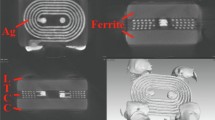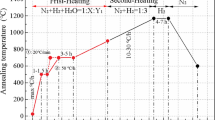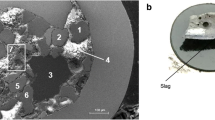Abstract
The medium frequency coreless induction furnace has gradually replaced the cupola in cast iron melting. However, induction coils at the bottom 1–6 turns can experience issues posing production and resulting safety risks. A kind of coil interturn breakdown failure caused by black attachment has occurred in our engineering practices. To explain the attaching and breakdown mechanism, an experimental investigation and detailed analysis of physical and chemical processes are performed. SEM, EDS and Fourier transform infrared spectrum results show that the attachment is primarily composed of free carbon, with a mass and atomic fraction of 62 and 71%, respectively. There were no C-H bonds in the powdered black attachment. The redox reactions of SiO2 and C, hydrogen and disproportionation reactions of CO and the ionization reactions of H2O contribute to the C transfers. The physical isolation of the Isoplan board, which prevents the mixture of CO, CO2, H2, H2O, and O2 from diffusing, causes C deposited only on the coil surface. The conductive carbon deposition in a moisture environment reduces the insulation degree of interturns and generates high-voltage discharge between adjacent coils. According to the findings, three improvement strategies are proposed and validated: (1) drilling holes in the Isoplan board; (2) unplugging the silicate insulating cloth in the lining sintering; and (3) as new lining is put into service, silicon steel sheets are prioritized for use as furnace charge.











Similar content being viewed by others
References
B. Jenkins, P. Mullinger, Industrial and process furnaces: principles, design and operation, 2nd edh (Elsevier, Amsterdam, The Netherlands, 2014)
P. Sinha, S.S. Chandra, An optimum design of the lining of a medium frequency induction melting furnace. Int. Trans. Oper. Res. 5(4), 255–259 (1998). https://doi.org/10.1016/S0969-6016(97)00020-8
V.R. Gandhewar, S.V. Bansod, A.B. Borade, Induction furnace–a review. Int J Eng Technol 3(4), 277–284 (2011)
N. Bara, Review paper on numerical analysis of induction furnace. Int J Latest Trends Eng Technol 2(3), 178–184 (2013)
K. Phelan, Safe maintenance of induction furnaces... it’s all in the details. modern casting. 24-28 (2022).
Y. Choi, H. Kim, D. Kim, E. Lee, H. Bae, Residual life prediction for induction furnace by sequential encoder with s-convolutional LSTM. Processes. 9(7), 1121 (2021). https://doi.org/10.3390/pr9071121
D.S. Smalley, Induction furnace electrical fundamentals & safety circuits, AFS International Iron Melting Conference IMC November, 2003.
A. Regordosa, N. Llorca-Isern, Chemical and structural characterization of slag compounds formed in the melting processes to produce spheroidal graphite cast irons. Inter Metalcast. 10, 421–434 (2016). https://doi.org/10.1007/s40962-016-0025-7
C. Hartung, M. Liptak, R. Logan et al., Thermochemical evaluation of cast iron slags generated from a holding furnace. Inter Metalcast. (2023). https://doi.org/10.1007/s40962-022-00947-x
C. Hartung, M. Liptak, R. Logan, L. Michels, Thermochemical evaluation of cast iron slags generated from a holding furnace. AFS Trans. 130, 225–233 (2022)
C. Lovegren, Evaluating the risk of corona discharge in superalloy vacuum induction melting furnace applications. Inter Metalcast. 14, 926–936 (2020). https://doi.org/10.1007/s40962-019-00392-3
R. Stark, Controlling carbon, sulfur and metal penetration of induction furnace linings. Modern Casting. 90(11), 25–28 (2000)
A. Bermúdez, D. Gómez, M.C. Muñiz, P. Salgado, R. Vazquez, Numerical simulation of a thermo-electromagneto-hydrodynamic problem in an induction heating furnace. Appl. Numer. Math. 59(9), 2082–2104 (2009). https://doi.org/10.1016/j.apnum.2008.12.005
A. Bermúdez, D. Gómez, M.C. Muniz et al., A FEM/BEM for axisymmetric electromagnetic and thermal modelling of induction furnaces. Int. J. Numer. Meth. Eng. 71(7), 856–878 (2007). https://doi.org/10.1002/nme.1952
J.R. Wang, P.Y. Hsueh, P.Y. Zeng, P.H. Chu, Applying ANN to analyze the influence on the recovery of chrome after silicon and aluminums’ melting of 15–5PH (V) in EAF, IEEE/SICE International Symposium on System Integration (SII). IEEE (2011). https://doi.org/10.1109/SII.2011.6147559
T. Kanno, Y. Iwami, T. Fukuo, N. Miyai, H. Nakae, Y. Hiramoto, Molten metal surface pattern and its generating mechanism in gray cast iron. Mater. Trans. 56(12), 2017–2022 (2015). https://doi.org/10.2320/matertrans.F-M2015827
A.S. Zavertkin, Effects of mixture composition on the lining stability of a crucible induction furnace. Refract. Ind. Ceram 49(3), 213–215 (2008). https://doi.org/10.1007/s11148-008-9067-6
A.S. Zavertkin, Effect of the lining and smelting technologies on slag formation in the induction-furnace smelting of cast iron. Refract. Ind. Ceram 54(1), 35–38 (2013). https://doi.org/10.1007/s11148-013-9544-4
V. Grachev, Features of cast iron smelting in induction crucible furnaces. Arch. Foundry Eng. 17(3), 45–50 (2017). https://doi.org/10.1515/afe-2017-0088
V.A. Grachev, Thermodynamics and mechanism of silicon reduction by carbon in a crucible reaction. Orient J Chem 32(6), 2929–2937 (2016)
J.K. Yang, Improve the service life of coreless power frequency induction melting furnace lining. Nonferrous Metall Equip 2, 23–29 (1993). ((Chinese))
W.J. Duca, Melting methods & materials div 8–09-031 mass transport of carbon, sulfur and moisture through a silica lining. Trans Am Found Soc 117, 673 (2009)
S.D. Ebbesen, S.H. Jensen, A. Hauch, M.B. Mogensen, High temperature electrolysis in alkaline cells, solid proton conducting cells, and solid oxide cells. Chem. Rev. 114(21), 10697–10734 (2014). https://doi.org/10.1021/cr5000865
Y. Shin, W. Park, J. Chang, J. Park, Evaluation of the high temperature electrolysis of steam to produce hydrogen. Int. J. Hydrogen Energy 32(10–11), 1486–1491 (2007). https://doi.org/10.1016/j.ijhydene.2006.10.028
R. Hino, K. Haga, H. Aita, K. Sekita, 38 R&D on hydrogen production by high-temperature electrolysis of steam. Nucl Eng Des. 233(1–3), 363–375 (2004)
D. Penchini, G. Cinti, G. Discepoli, U. Desideri, Theoretical study and performance evaluation of hydrogen production by 200 W solid oxide electrolyzer stack. Int. J. Hydrogen Energy 39(17), 9457–9466 (2014). https://doi.org/10.1016/j.ijhydene.2014.04.052
G. Schiller, M. Lang, P. Szabo, N. Monnerie, H.V. Storch, J. Reinhold, P. Sundarraj, Solar heat integrated solid oxide steam electrolysis for highly efficient hydrogen production. J. Power Sources 416, 72–78 (2019). https://doi.org/10.1016/j.jpowsour.2019.01.059
H. Zhang, S. Su, X. Chen, G. Lin, J. Chen, Configuration design and performance optimum analysis of a solar-driven high temperature steam electrolysis system for hydrogen production. Int. J. Hydrogen Energy 38(11), 4298–4307 (2013). https://doi.org/10.1016/j.ijhydene.2013.01.199
X.F. Pang, G.F. Shen, The changes of physical properties of water arising from the magnetic field and its mechanism. Mod. Phys. Lett. B 27(31), 1350228 (2013). https://doi.org/10.1142/S021798491350228X
X.F. Pang, The conductivity properties of protons in ice and mechanism of magnetization of liquid water. Eur Phys J B-Condens Matter Complex Syst 49(1), 5–23 (2006). https://doi.org/10.1140/eojb/e2006-00020-6
G. Akgül, A. Kruse, Influence of salts on the subcritical water-gas shift reaction. J Supercrit Fluids 66, 207–214 (2012). https://doi.org/10.1016/j.supflu.2011.10.009
R.L. Keiski, O. Desponds, Y.F. Chang, G.A. Somorjai, Kinetics of the water-gas shift reaction over several alkane activation and water-gas shift catalysts. Appl. Catal. A 101(2), 317–338 (1993). https://doi.org/10.1016/0926-860X(93)80277-W
W.H. Chen, C.Y. Chen, Water gas shift reaction for hydrogen production and carbon dioxide capture: a review. Appl Energy. 258, 114078 (2020)
N. Yoshida, T. Yamamoto, F. Minoguchi, S. Kishimoto, Effect of hydrogen on carbon deposition from carbon monoxide on nickel catalyst. Catal. Lett. 23(3), 237–243 (1994). https://doi.org/10.1007/BF00811358
Y. Tao, S.D. Ebbesen, M.B. Mogensen, Degradation of solid oxide cells during co-electrolysis of steam and carbon dioxide at high current densities. J. Power Sources 328, 452–462 (2016). https://doi.org/10.1016/j.jpowsour.2016.08.055
K. Nishihiro, T. Maeda, K. Ohno, K. Kunitomo, Effect of H2 concentration on carbon deposition reaction by CO–H2 gas mixture at 773–973 K. ISIJ Int. 59(4), 634–642 (2019). https://doi.org/10.2355/isijinternational.ISIJINT-2018-393
L. Chen, Y. Shi, N. Cai, Carbon deposition on nickel cermet anodes of solid oxide fuel cells operating on carbon monoxide fuel. J. Power Sources 225, 1–8 (2013). https://doi.org/10.1016/j.jpowsour.2012.10.018
S. Geng, W. Ding, S. Guo, X. Zhou, Y. Zhang, X. Lu, Carbon deposition on iron surfaces in CO–CO2 atmosphere. Ironmaking Steelmaking 42(9), 714–720 (2015). https://doi.org/10.1179/1743281215Y.0000000049
W. Zhang, K. Li, J.H. Dong, C.Z. Li, A.H. Liu, J.H. Zhang, Z.L. Xue, Kinetic triplet from low-temperature carburization and carbon deposition reactions. J. Iron. Steel Res. Int. 29(10), 1545–1558 (2022). https://doi.org/10.1007/s42243-022-00780-w
P. Stamenov, J.M.D. Coey, Magnetic susceptibility of carbon—experiment and theory. J magnetism and magnetic materials. 290, 279–285 (2005)
Acknowledgments
The work is financially supported by the Major Science and Technology Innovation Engineering project of Shandong Province, China (Grant No. 2019JZZY010445).
Author information
Authors and Affiliations
Corresponding author
Ethics declarations
Conflict of interest
On behalf of all authors, the corresponding author states that there is no conflict of interest.
Additional information
Publisher's Note
Springer Nature remains neutral with regard to jurisdictional claims in published maps and institutional affiliations.
Rights and permissions
Springer Nature or its licensor (e.g. a society or other partner) holds exclusive rights to this article under a publishing agreement with the author(s) or other rightsholder(s); author self-archiving of the accepted manuscript version of this article is solely governed by the terms of such publishing agreement and applicable law.
About this article
Cite this article
Cong, J., Wang, H., Wang, D. et al. Study on Carbon Deposition and Coil Breakdown Mechanism of Medium Frequency Coreless Induction Furnace. Inter Metalcast 18, 1236–1246 (2024). https://doi.org/10.1007/s40962-023-01122-6
Received:
Accepted:
Published:
Issue Date:
DOI: https://doi.org/10.1007/s40962-023-01122-6




